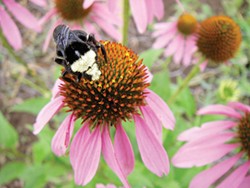[
{
"name": "Top Stories Video Pair",
"insertPoint": "7",
"component": "17087298",
"parentWrapperClass": "fdn-ads-inline-content-block",
"requiredCountToDisplay": "1"
}
]
I am primarily a food gardener, but there are a handful of flowering medicinal plants that I always include in my garden. Not only useful for home remedies, they provide beautiful cut flowers, improve soil and attract beneficial insects. Many of the plants listed here are commonly bred and cross-bred to produce ornamental variations, so be sure to note the species and choose the non-hybrid option.
Here are my 10 favorite medicinal flowers and some tips on how to grow and use them.
Angelica (Angelica archangelica)
A tall, self-seeding biennial that smells amazing and puts out thick stalks with clusters of tiny flowers. Angelica has a wide range of uses, from tummy aches to menstrual issues. The large umbels attract beneficial wasps that will eat more troublesome insect pests. It grows easily in part shade. Give it some room on the edge of the garden so it doesn't crowd out your other plants.
Calendula (Calendula officinalis)
I scatter calendula seed around the garden wherever there is bare soil. It grows almost anywhere and is easy enough to remove when you decide to put something else in its place. A common ingredient in salves, calendula is known to heal the skin from sunburn, rashes and scrapes.
Clary Sage (Salvia sclarea)
A gorgeous biennial aromatic, clary sage is one of my favorite plants of all time. The smell is said to help cure depression and the long stalks of purple flowers are beautiful in a vase. Attracts bees and hummingbirds.
Echinacea (Echinacea purpurea)
Known as a powerful antibiotic and antiviral medicine, echinacea is an easy-to-grow perennial that puts out large purple flowers for several months a year. If you start it from seeds, be sure to cold-stratify them by putting them in the fridge for a couple of weeks before planting. Bumblebees love it!
Elecampane (Inula helenium)
A large, leafy biennial that produces yellow daisy-like flowers. Elecampane is known for medicinal properties that help with lung problems, congestion, colds and the like.
Hops (Humulus lupulus)
Not a traditional cut flower, but try some vines of blooming hops in a flower arrangement. They look amazing! This is one of my favorite plants to make into tincture and use as a sleep aid. Plus, you know, beer.
Passionflower (Passiflora incarnata)
Another wonderful sleep tincture, passionflowers also attract a wide range of beneficial insects. The flowers are stunning and the perennial, evergreen vines grow easily on a fence or trellis. The plants can be slow to start but once they take off, watch out!
Rose (Rosa canina)
Also known as "dog rose," this is my favorite species to use for rose hips. Rose hips are rich in vitamin C. Mix with apple peel and vanilla bean to make a delicious tea that is safe for children and the whole family.
Valerian (Valeriana officinalis)
No garden is complete without a patch of valerian. They prefer sun but will do fine in part shade as well. The flowers smell delicious — not as pungent as the roots, which are the part that is most commonly used as a medicinal. Valerian root is used as muscle relaxant, a calming herb, and in folklore is commonly said to help cure heartbreak. Cut flowers also look wonderful in a bouquet.
Yarrow (Achillea millefolium)
If you cut yourself in the garden, grab some yarrow, chew on it for a minute and put it on the wound. It will help stop the bleeding. I like to harvest the leaves and flowers, dry them, powder them and keep in a jar to use as a styptic.
Finally, please remember that I am not an herbalist nor am I a doctor, and so I'm indicating common usages for these plants, based on my personal knowledge and experience. But don't just take my word for it! Take an herbal medicine class, do your own research and/or consult with your doctor.
Heather Jo Flores wrote Food Not Lawns, How to Turn Your Yard into a Garden and Your Neighborhood into a Community. Visit www.heatherjoflores.com.
Comments
Showing 1-1 of 1
more from the author
-
Tales from the Underground
A rainbow of roots from around the world
- Sep 21, 2017
-
Hashtag, Bumper Crop
Veggies to plant now for fall and winter
- Aug 17, 2017
-
Plotting Out Your Garden: Part 2
- Apr 6, 2017
- More »


































